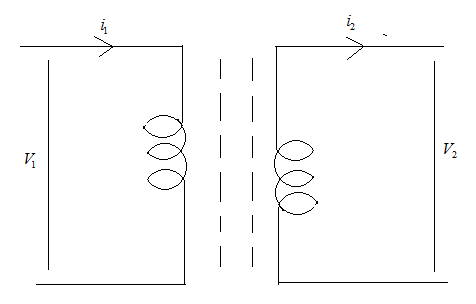
Answer
459k+ views
Hint: In this question, we need to draw a labelled diagram of a device that would be used to transform 200 V ac to 15 V ac. For this, we will use the basic electrical concept to get the result.
Complete step by step answer:
Input voltage \[{V_{in}} = 200V\]
Output voltage \[{V_{out}} = 15V\]
Here since input voltage is greater than the output voltage, we can say the voltage is being stepped down, and this occurs in a step-down transformer.
We know that the level of voltage in the transformer is changed by increasing or decreasing the number turns of windings and in a step-down transformer turns in the primary winding is more than the turns in the secondary winding.

A transformer works on the principle of electromagnetic induction, which states the rate of change of flux linkage with respect to time is directly proportional to the induced emf in the coil.
When an alternating voltage is supplied to the primary coil it produces a continuous changing flux and this flux links with the secondary winding, and according to Faraday's law of electromagnetic induction when a coil is brought in a continuous changing flux-region an emf is induced, and this emf produces a voltage in the secondary coil.
Some of the major applications (uses) of the step-down transformers are impedance matching, isolating two circuits electrically, rectifiers, relays, etc.
Note:Since the voltage is being transformed from 200 V ac to 15 V ac it is a step-down transformer. A transformer is a static device which transforms power from one level to another level without frequency being changed.
Complete step by step answer:
Input voltage \[{V_{in}} = 200V\]
Output voltage \[{V_{out}} = 15V\]
Here since input voltage is greater than the output voltage, we can say the voltage is being stepped down, and this occurs in a step-down transformer.
We know that the level of voltage in the transformer is changed by increasing or decreasing the number turns of windings and in a step-down transformer turns in the primary winding is more than the turns in the secondary winding.

A transformer works on the principle of electromagnetic induction, which states the rate of change of flux linkage with respect to time is directly proportional to the induced emf in the coil.
When an alternating voltage is supplied to the primary coil it produces a continuous changing flux and this flux links with the secondary winding, and according to Faraday's law of electromagnetic induction when a coil is brought in a continuous changing flux-region an emf is induced, and this emf produces a voltage in the secondary coil.
Some of the major applications (uses) of the step-down transformers are impedance matching, isolating two circuits electrically, rectifiers, relays, etc.
Note:Since the voltage is being transformed from 200 V ac to 15 V ac it is a step-down transformer. A transformer is a static device which transforms power from one level to another level without frequency being changed.
Recently Updated Pages
10 Examples of Evaporation in Daily Life with Explanations

10 Examples of Diffusion in Everyday Life

1 g of dry green algae absorb 47 times 10 3 moles of class 11 chemistry CBSE

What is the meaning of celestial class 10 social science CBSE

What causes groundwater depletion How can it be re class 10 chemistry CBSE

Under which different types can the following changes class 10 physics CBSE

Trending doubts
Fill the blanks with the suitable prepositions 1 The class 9 english CBSE

Which are the Top 10 Largest Countries of the World?

How do you graph the function fx 4x class 9 maths CBSE

Differentiate between homogeneous and heterogeneous class 12 chemistry CBSE

Difference between Prokaryotic cell and Eukaryotic class 11 biology CBSE

Change the following sentences into negative and interrogative class 10 english CBSE

The Equation xxx + 2 is Satisfied when x is Equal to Class 10 Maths

In the tincture of iodine which is solute and solv class 11 chemistry CBSE

Why is there a time difference of about 5 hours between class 10 social science CBSE




